|
HABITAT VALUE OF
SHELL MOUNDS TO ECOLOGICALLY AND COMMERCIALLY IMPORTANT BENTHIC
SPECIES
Principal Investigators: Mark Page
(UCSB),
Jenifer Dugan (UCSB) and
James Childress
(UCSB)
Summary
of Research
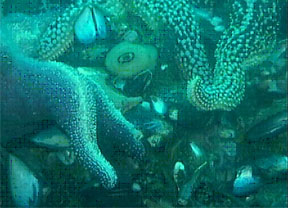 Shell mounds form over time under offshore oil platforms
as encrusting invertebrates, chiefly mussels, barnacles, and scallops,
fall from the platform support surfaces and accumulate on the
substratum. These mounds provide habitat for a diverse
invertebrate community that depends on organic input in the form of
faunal litterfall from the overlying structure for nourishment.
When platforms are decommissioned and removed, the shell mounds remain,
but faunal litterfall is no longer available as a food source for the
shell mound Shell mounds form over time under offshore oil platforms
as encrusting invertebrates, chiefly mussels, barnacles, and scallops,
fall from the platform support surfaces and accumulate on the
substratum. These mounds provide habitat for a diverse
invertebrate community that depends on organic input in the form of
faunal litterfall from the overlying structure for nourishment.
When platforms are decommissioned and removed, the shell mounds remain,
but faunal litterfall is no longer available as a food source for the
shell mound 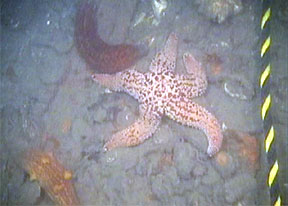 community.
The fate of shell mounds following platform decommissioning and removal
is controversial, because their habitat value is unknown. To assess
habitat value of these mounds relative to shell mounds with existing
platforms and to natural reefs, we compared the distribution and
abundance of commercially important crab species (Cancer antennarius,
C. anthonyi,
C. productus, and Loxorhynchus grandis) and
other invertebrate and fish taxa. In addition we compared the
size structure and growth rates of these organisms among habitats. community.
The fate of shell mounds following platform decommissioning and removal
is controversial, because their habitat value is unknown. To assess
habitat value of these mounds relative to shell mounds with existing
platforms and to natural reefs, we compared the distribution and
abundance of commercially important crab species (Cancer antennarius,
C. anthonyi,
C. productus, and Loxorhynchus grandis) and
other invertebrate and fish taxa. In addition we compared the
size structure and growth rates of these organisms among habitats.
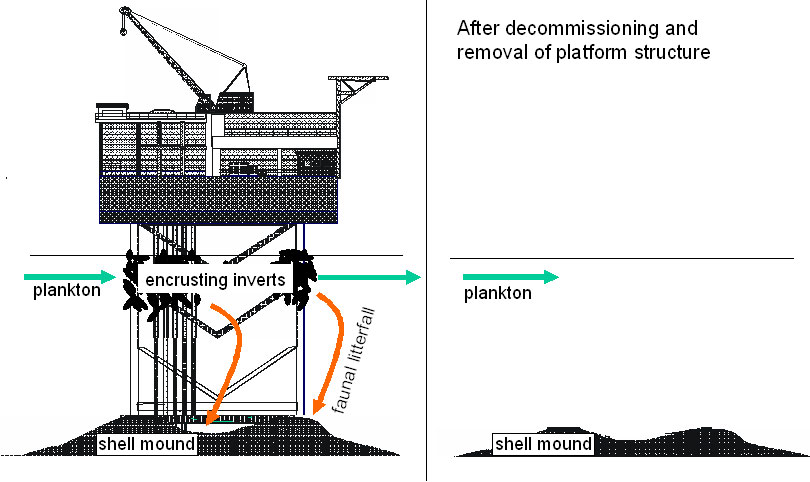
Figure 1. Illustration of the fall of mussels and other organisms from
offshore oil platforms to the sea floor and the formation and
topography of shell mounds before and after platform removal.
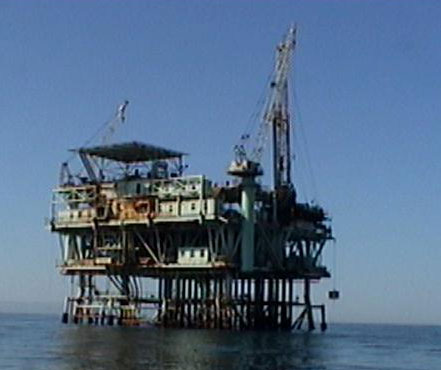 Using
shell mounds under existing platforms “Hogan,” “Houchin” (Pacific
Operators Offshore), and “Gina” (Nuevo Energy Company), and shell
mounds at the sites of four decommissioned platforms “Hazel”, “Hilda”,
“Hope”, and “Heidi” we: (1) quantified the abundance and
distribution of ecologically and commercially important benthic
organisms on the shell mounds, (2) determined the population size
structure of the most abundant taxa at each site, (3) used the growth
rates of organisms to evaluate the habitat value of shell mounds.
The results of our research will potentially contribute to decisions
regarding shell mound fate following platform decommissioning. Using
shell mounds under existing platforms “Hogan,” “Houchin” (Pacific
Operators Offshore), and “Gina” (Nuevo Energy Company), and shell
mounds at the sites of four decommissioned platforms “Hazel”, “Hilda”,
“Hope”, and “Heidi” we: (1) quantified the abundance and
distribution of ecologically and commercially important benthic
organisms on the shell mounds, (2) determined the population size
structure of the most abundant taxa at each site, (3) used the growth
rates of organisms to evaluate the habitat value of shell mounds.
The results of our research will potentially contribute to decisions
regarding shell mound fate following platform decommissioning.
We investigated the distribution and
abundance of benthic invertebrates using two techniques. For
commercially important crabs, baited commercial crab traps were
deployed at each soft bottom, reef, shell mound, and platform location
(excluding platform Gina). Traps were lowered to the bottom at
each sampling location and retrieved after a 24-hour soak time.
Captured crabs were counted, sexed, and carapace length (for majid
crabs) or carapace width (for cancrid crabs) was measured.
Sampling was repeated once a month for 4 months beginning in
September. Our second technique used band transects to estimate
the abundance of invertebrate taxa other than crabs on the two shallow
shell mounds (Hazel and Hilda), on soft bottom adjacent to Hazel,
Hilda, and Gina, and on the shell mound at platform Gin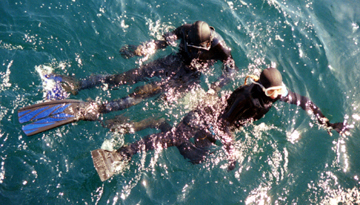 a. Divers
attached transect lines to a central point (the buoy chain at the
shallow shell mounds, the research vessel’s anchor line on the soft
bottom sites and a conductor pipe on platform Gina), and extend the
lines out in a radial fashion; the result was a “wheel spoke” sampling
regime. The divers then swam the length of the transects and
collected selected benthic macroinvertebrate taxa in a one meter
swath. In order to correct for potential over sampling of the
area closest to the central point inherent in this sampling design, the
transects were divided into 4 segments. For analysis, data was
weighted with regard to distance from the central point, e.g. the
segments closest to the central point were weighted less than those
farther away. a. Divers
attached transect lines to a central point (the buoy chain at the
shallow shell mounds, the research vessel’s anchor line on the soft
bottom sites and a conductor pipe on platform Gina), and extend the
lines out in a radial fashion; the result was a “wheel spoke” sampling
regime. The divers then swam the length of the transects and
collected selected benthic macroinvertebrate taxa in a one meter
swath. In order to correct for potential over sampling of the
area closest to the central point inherent in this sampling design, the
transects were divided into 4 segments. For analysis, data was
weighted with regard to distance from the central point, e.g. the
segments closest to the central point were weighted less than those
farther away.
** Click
here for Final Report
|
[homepage]
|
[overview]
|
[researchers]
| [students
& staff]
|
[research] | [download reports]
|
|

